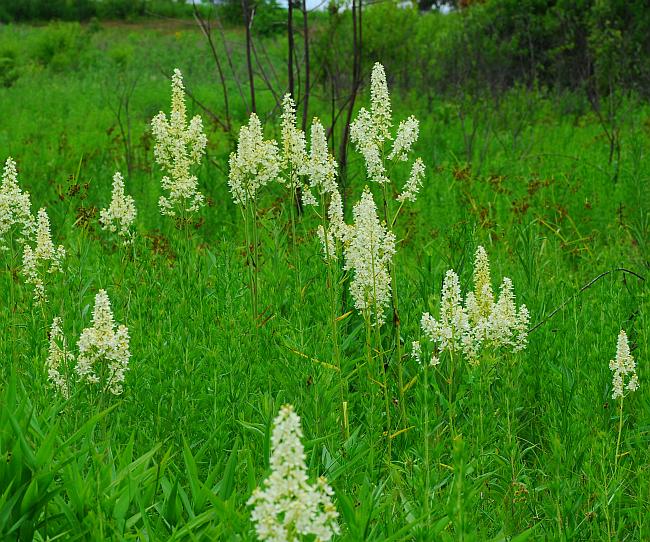Melanthium virginicum L.
Bunchflower

Native
CC = 9
CW = -3
MOC = 40
© SRTurner
Melanthium virginicum L.Bunchflower | |
 |
Native CC = 9 CW = -3 MOC = 40 |
© SRTurner |
|
Family - Liliaceae Habit - Perennial forb, with short rhizomes, lacking the odor of onion or garlic. Stem - Aerial stems erect, to 150 cm long, the bases slightly bulbous-thickened and often coated with dense parallel fibers formed from the decayed remains of previous years' leaf bases, unbranched below the inflorescence, pubescent with short, curly hairs.
Leaves - Numerous, mostly basal, glabrous, those on the aerial stems greatly reduced and mostly bractlike, the basal leaves 20-50 cm long, linear, flat or more often folded longitudinally.
Inflorescence - Terminal panicle of numerous flowers, those near the tip sometimes functionally staminate, the remainder usually functionally perfect.
Flowers - Subtended by small bracts, with stalks 4-22 mm long, never replaced by bulblets. Perianth 6-12 mm long, the tepals fused at the base, these with a stalklike basal 1/3 and with a pair of large, yellow to greenish brown glands at the base of the expanded, bladelike portion, milky white to pale yellow, turning greenish yellow with age, somewhat pubescent with short curly hairs on the outer (under) surface. Stamens 6, fused to the base of the stalklike portions of the perianth. Styles 3, each with a small stigma. Ovary superior, with 3 locules, each with 4-10 ovules.
Fruits - Capsules 10-18 mm long, ovoid, deeply 3-lobed, the lobes beaked with the persistent styles.
Flowering - June - August. Habitat - Wet to mesic prairies, fens, streambanks, railroads. Origin - Native to the U.S. Lookalikes - None when flowering. Vegetatively, the plants resemble several others, including species of Veratrum and Stenanthium. Other info. - This striking and unusual plant has been found in scattered locations throughout Missouri and the eastern continental U.S., but is not particularly common anywhere. Experience suggests that it is found mostly in moist, high quality prairie habitats, though Yatskievych specifically mentions "degraded remnant prairie" as a habitat preference. Its conservation coefficient (2015) is 9. When not flowering its basal leaves can be confused with those of closely related plants. The distinction lies in the leaf width, with those of Melanthium being broader than those of Stenanthium but much narrower than the elliptic to broadly oblanceolate basal leaves of Veratrum woodii. Photographs taken at Providence Prairie, Lawrence County, MO., 6-18-05 (DETenaglia); also at Shaw Nature Reserve, Franklin County, MO, 6-26-2013 and 7-1-2013, and at Tucker Prairie Natural Area, Callaway County, MO, 7-3-2015 (SRTurner). |